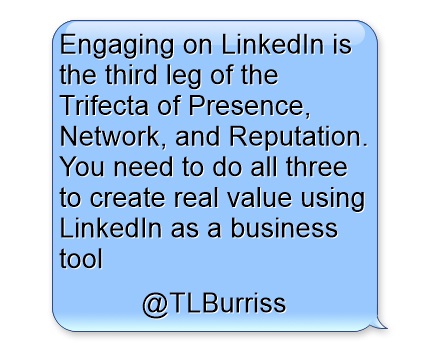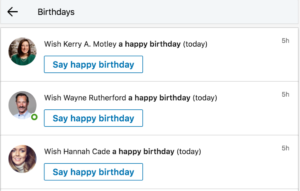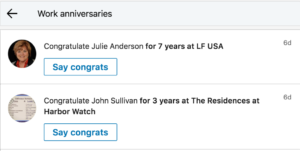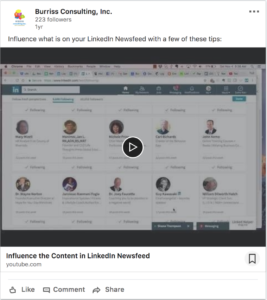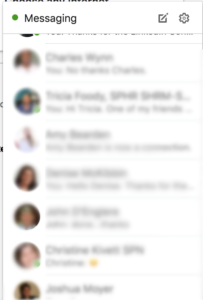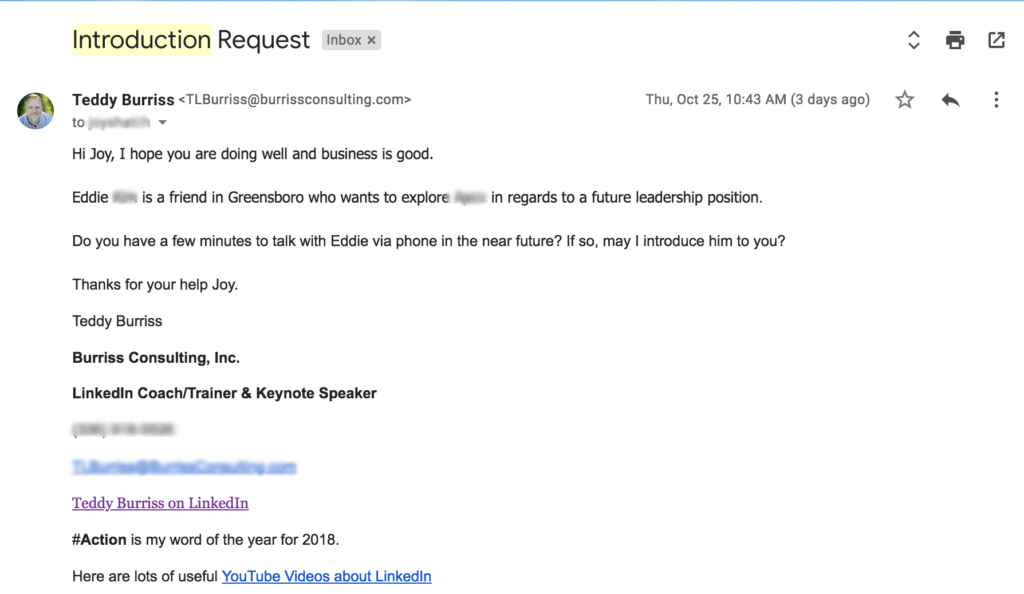Having an absolutely fabulous LinkedIn Profile is a great step towards using LinkedIn as a business tool. Congratulations if you have a fabulous profile.
Growing a highly relevant and meaningful LinkedIn Network is another great step towards creating value using LinkedIn as a business tool. Congratulations if you are building a great LinkedIn Network.
However, it’s engagement in and beyond LinkedIn that provides the greatest benefits.
Here are 10 ways to engage in LinkedIn (and beyond) and the benefits of each:
#10 – Birthday notifications. Many ask, “Why does LinkedIn think it’s useful to notify us of our connection’s birthdays?” I believe the LinkedIn birthday notifications are a great way to engage with our primary LinkedIn Connections.
I won’t acknowledge every birthday, however daily I look at these notifications to see if there is someone in the list I want to talk with, who may be using LinkedIn and will get my birthday note.
I also will not use the default button ‘Say Happy Birthday’ That is not real engagement, it’s just button pushing. I always go to their LinkedIn Profile and either send them a message, an email or I call them, depending on my relationship with them.
Done properly acknowledging a prospect or client’s birthday can be a good way to start or restart a conversation.
#9 – New Job/Role notifications. This notification can be inaccurate sometimes, however for my prospects and important clients, I will take the time to confirm the notification and then acknowledge the change in their career or business.
As with the birthday notification, I’ll either use a LinkedIn message, email or phone call based on my relationship with the connection.
I verify the job/role announcement from their LinkedIn Profile and depending on the change and my relationship with the LinkedIn Member, I will use either a LinkedIn message, email or phone call to contact them and chat about the change.
Again, this is a great way to start or restart a conversation with our LinkedIn Connections.
#8 – Like, Comment, or Share their Company Page content. Typically LinkedIn Company Page content is published and monitored by the marketing department. However, I follow the LinkedIn Company pages of my prospects and my clients, mostly to stay aware of any business updates or activities of these companies.
Seeing interesting posts from my target companies gives me the opportunity to engage on this content and even to @mention my prospects or clients in comments or shares of the content, which will notify them when I do this.
This engagement can show my prospects and clients that I care enough to pay attention to their companies and as indicated before to create an opportunity to start or restart a beneficial conversation.
#7 – LinkedIn Messages. LinkedIn messaging is the least useful direct 1:1 communications method to engage with our LinkedIn Connections. However, these messages can still be useful engagement, when used properly.
I’ll test the response from a new LinkedIn Connection by sending them a LinkedIn message regarding a company success or press release I discover online. If they respond then I know they are paying attention to LinkedIn messages. If they don’t respond then I know LinkedIn messaging is not as important to them.
I try not to use LinkedIn messaging with a connection if they did not respond to my last message.
Some of our LinkedIn Connections will not engage in LinkedIn messaging. Some won’t use email or text messaging either. What we need to do is discover what communication method is the best for different LinkedIn Connections and when we need to message them, use the platform they prefer.
The benefit of LinkedIn messenger is it’s quick and easy, however only truly useful if the other person uses it as well.
#6 – Introduce your LinkedIn Connections to each other. Engagement with our LinkedIn Network should not be all about us or our business. Engaging with our connections in ways that help them is important to do. One way to do this is to make introductions.
I enjoy introducing my LinkedIn connections to each other, for meaningful reasons. Done properly these introductions can create business, career and/or community value for the LinkedIn Members we introduce to each other.
If you purposefully introduce two people to each other and something great comes from the introductions, these connections could be greatly appreciative, and they could reciprocate in the future. Remember though, never help someone else with the explicit expectations of something in return. This will not work well at all.
I usually make these introductions through email, not LinkedIn messaging.
#5 – Like, comment or share their personal shares/comments. When someone acknowledges us for the content we share by engaging on it, we are appreciative.
Furthermore, when we engage on our LinkedIn Connection’s content we create the opportunity to be discovered for our own expertise, skills, opinions, and perspectives.
There are three ways to engage directly on content we find in the LinkedIn newsfeed and in LinkedIn Groups:
1 – Like – Liking content and comments in the newsfeed or in Groups is a simple way to let your LinkedIn Connection know you saw and appreciate the content or comment.
2 – Comment – Commenting on content or replying to a comment is a good way to actually join the conversation. Doing so creates the potential to be discovered as an authority in the conversation when you engage in meaningful and useful ways.
3 – Share – Sharing the content your LinkedIn Connections posts creates the potential for the rest of your LinkedIn Network to discover this content. This is a great way to provide value to the author of the content and to help your network at the same time.
You can also share your LinkedIn Connection’s content outside of LinkedIn as long as they made the post public. If there is a share button on the post, it’s public and shareable.
Remember, never engage on any content that could diminish your professional brand.
#4 – Immediately Engage upon connecting on LinkedIn. Just as when meeting someone new in real life, we don’t exchange business cards and then walk away. We should strive to strike up a conversation.
Networking on LinkedIn works best when we engage immediately. I do this a few different ways.
If I get an invite to connect from someone I do not know, I message them with this message:
“Hello {NAME}.
Thanks for the invite to connect.
Please remind me, have we met or talked yet, or has someone referred me to you.
If you are interested in LinkedIn training or coaching, please let me know what type of support you need, individual or group.
I look forward to your reply.
Thanks,
Teddy Burriss”
###
BTW – I give them 1 week to respond to my query. If they don’t then I ignore the invitation to connect.
Once I accept the invitation from another LinkedIn Member, I follow up with a phone call, email or a LinkedIn message.
I’ll call the new connection if I can easily find their phone number and they are highly relevant to my business goals. I’ll make the conversation all about them until I get permission to talk about myself. I may invite them to a follow-up conversation if they would like.
If I don’t have a phone number, I’ll send hem an email again, making the conversation all about them, possibly with the offer to talk later if they would like.
If I don’t feel the new LinkedIn Connection is highly relevant to my business goals, I’ll send this LinkedIn message:
“Thanks for the LinkedIn Connection {name}. I appreciate this.
Feel free to message me on LinkedIn with any question about using LinkedIn as a business tool. The questions I get, and answer, often allow me to create a blog post or video on a new topic.
Have a great day
Teddy Burriss
Burriss Consulting, Inc.
LinkedIn Coach & Trainer
skype: tlburriss
xxx-xxx-xxxx
me@me-again.com”
###
The reason I invest this time in the initial messaging is so I can move a connection into a basic relationship, where possible and relevant.
#3 – Email Messages. Every engagement with our prospects or clients does not need to be done within LinkedIn. We need to communicate with our network in the ways they want. Today, email is still considered a primary business messaging tool.
Email messages can be useful for sharing ideas and information your LinkedIn network could benefit from seeing. Use email in the process of developing a relationship, prior to moving into the sales steps.
Again, remember to make the email message in context to your connection until you get permission to move the conversation to about you and your business. You could end the message with a call to action to continue the conversation later if they would like.
#2 – Phone Calls. I will periodically call my LinkedIn Connections if they are highly relevant to my business.

Sometimes if my call is the first one with a specific connection, I’ll start the conversation with these words: “Hi {Name}, I looked at my notes and do not see that we have talked yet, so I decided to call and say hello. Do you have just a moment?”
I’ll ask the other person a few questions about themselves, their company and their role in the business. If I don’t get invited to share about myself, I’ll end with a conversation with an offer to contact me directly if they ever want to talk about how I could help them in regard to my business.
I do this to ‘poke’ my LinkedIn connection and to look for opportunities to move my connections into a meaningful conversation, hopefully, business-related.
#1 – Meet IRL (in real life). I firmly believe the best manner of engaging is what I call, knee cap to knee cap, i.e., face to face, or in person.
Therefore, where possible and relevant I’ll ask my prospects and clients to meet in person.
One way I do this is when I travel out of town, I’ll look to see who I know in that town and I’ll let them know I’m coming to town and ask if they have a few minutes to meet.
I’ve discovered for myself that asking 15-20 people each time I travel if they want to meet will usually get at least one person to accept the invite.
Summary:
There are two primary reasons I invest time in these activities.
The first reason is for relationship development with my most important viewers, aka prospects and clients. Engaging with them, about them and their business and/or their interests is a great way to nurture the relationship.
The second reason I invest time in these engagement activities is to develop my reputation in context to what I engage on. Getting into conversations with my prospects and clients and sharing my ideas and perspectives allows me to demonstrate my experiences and skills, thus position myself as an authority in the space I engage in.
Build a professional LinkedIn Profile.
Grow a highly relevant LinkedIn Network.
And, don’t forget to engage with your prospects and clients in many different ways, relevant to them and the work you do.
/Teddy
